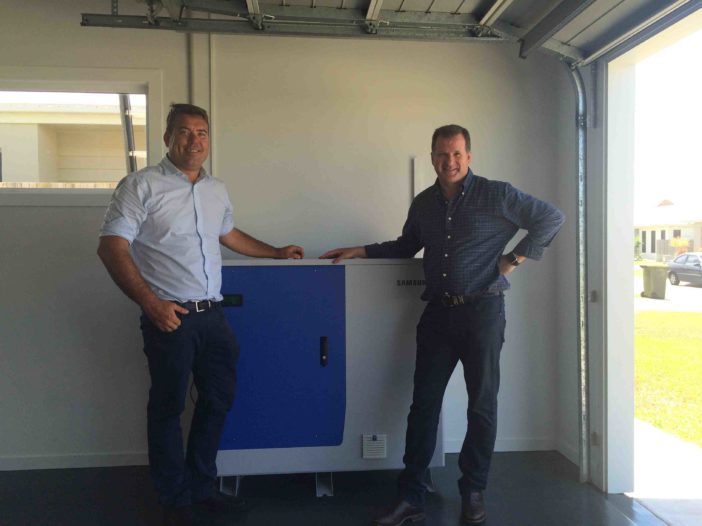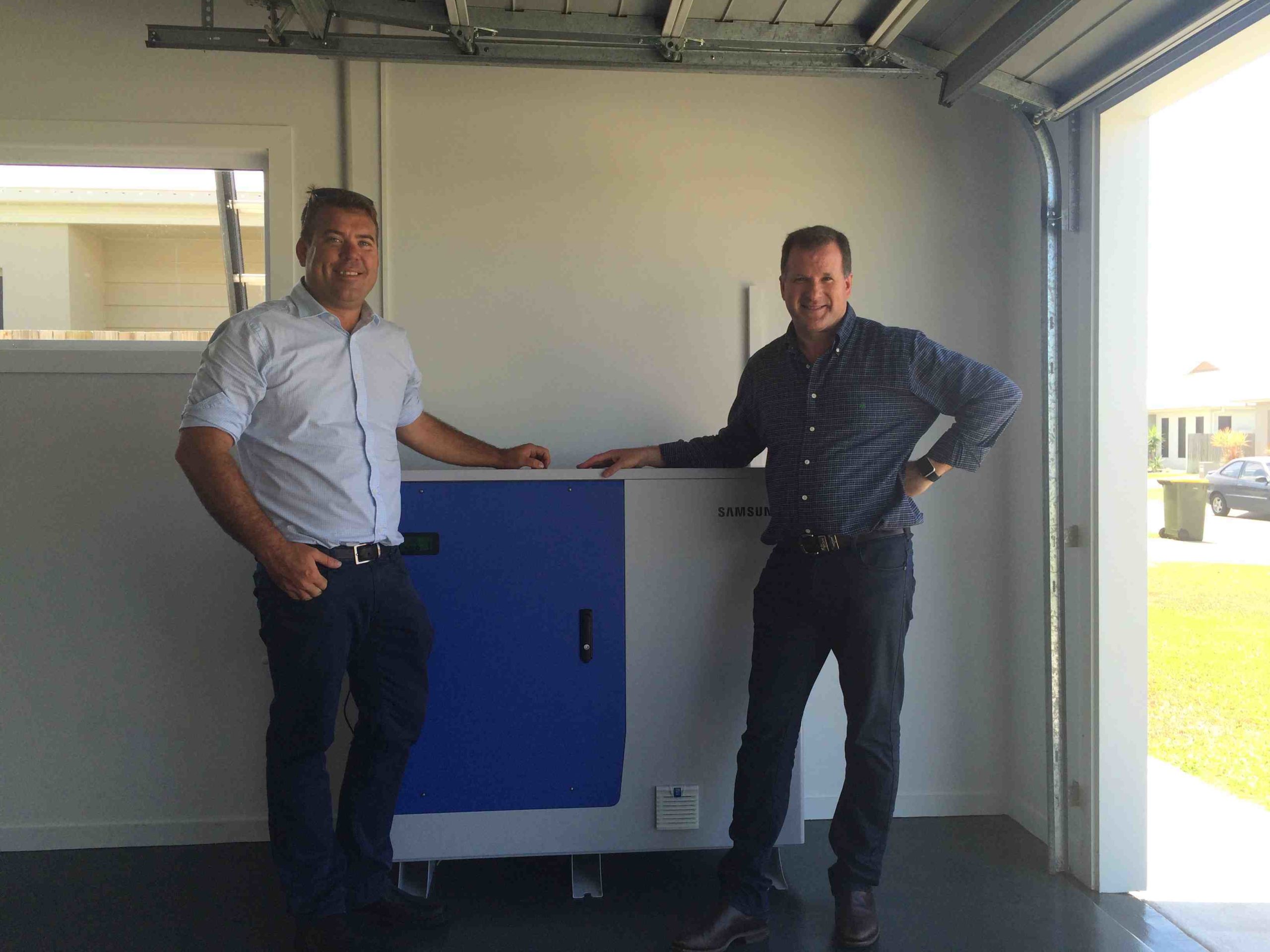
In Australia, the utility lobby says that the payback time to take a suburban home off grid is nearly 30 years. But soaring fixed network charges, and plunging battery storage costs, are rapidly changing the equation. In northern Queensland, the pay-back time may be as little as 7.5 years.
Steve Madson, the head of Country Solar, is feeling pretty pleased with himself.
Five days after installing a 10.8kWh Samsung lithium-ion battery storage system in his suburban Townsville home in north Queensland, and three days after (temporarily) flicking the switch from the grid, Madson is watching the rain fall – and the charge in his battery storage system is still going up.
“Last night was the first rains for the year in Townsville and it was very welcome, because many suburbs in town have power outages because of the rain,” Madson tells One Step Off the Grid. “I decided to make sure I drained my battery to see how much charge I could put in with a rainy, overcast day.
“I have 5KW of solar on my roof currently and I will lift that to 6.5KW in the coming weeks. Right now, my pool pump is running, two fridges and all standby equipment is on – and my battery is charging and has come from 6 per cent to 18 per cent in the pouring rain!!!”
That was Madson speaking at 10am. By the end of the day, despite the rain and the cloudy weather, the battery storage system had charged to 65 per cent. It would have been fully charged if he hadn’t left the pool pump on, but he was keen to test the system.
The result is good news for Madson, because in the next few weeks he intends to take his home permanently off the grid, and judging by the number of inquiries his business is receiving (about 50 a week), he expects many others to follow.
That’s because for an all in cost of around $25,000, consumers can get a 10.8kWh battery storage system and around 7kW of rooftop solar. In north Queensland, that’s enough to take a home off grid, and deliver a payback of 7.5 years. That’s one reason why Madson decided that he’d better lead by example.
 He has taken delivery of one of the first Samsung 10.8kWh systems, the first scaleable grid-connected Samsung system in the world, and in his case, the first to be used in an off-grid application.
He has taken delivery of one of the first Samsung 10.8kWh systems, the first scaleable grid-connected Samsung system in the world, and in his case, the first to be used in an off-grid application.
“This unit is the first of its kind installed in the world, we have this unit currently still connected to the grid whilst we learn all the features and functions though we plan to be off grid completely at the start of December.”
And Madson does not anticipate problems with going off grid. His 6.5kW of rooftop solar PV will produce more than 24.5kWh per day in winter, more than his home usage of 18kWh a day. In summer, the system will produce an average of 38kWh per day, more than covering his increased usage of 30kwh per day.
“I have a swimming pool, an aquaponics vegetable garden, we are in a hot humid environment so the house is air-conditioned with inverter split system air cons,” Madsons says.
“Because of the grid service fees my initial back up power will be a backup LPG generator, although I will purchase an electric vehicle early in the New Year and that will remove the need for the backup generator.” Here is a screenshot of his solar power output, his battery storage status, and his load, from Wednesday.
 Madson says he would prefer to stay connected with the grid, but the connection charges make no sense, given the rising fixed network charges imposed by the local operator. (See this for more details of Queensland fixed charges).
Madson says he would prefer to stay connected with the grid, but the connection charges make no sense, given the rising fixed network charges imposed by the local operator. (See this for more details of Queensland fixed charges).
“When home energy storage with lithium-ion battery technology started to become a reality I was getting really excited, both for myself having a new toy but also for the greater good of the community,” Madson says.
“For years I have been told the reason electricity prices are so high is because solar does not influence peak demand, that peak demand in sunny North Queensland where I live happens in the early evening these days and that is due to air-conditioning loads.
“I wondered if solar storage households like mine be connected to the grid and used as a filter to level grid demand. Wouldn’t the ability to help the grid by feeding from your home energy storage system or EV solve the greatest problem in the history of the centralised power network?”
Apparently not. The Ergon network they have increased the daily service charges and added metering charges which, when added up, amount to around $600 a year.
“That leads me to believe they will continue to increase fixed charges and lower the rate of electricity. But even if it remains at $600 a year over the expected 15 year life of my (storage) investment, that is $9,000 of fixed charges and $9,000 buys me a lot of extra redundancy to ensure I won’t need the grid.”
Madson says the $25,000 cost of such a bundle should deliver a payback of around 7.5 years, given the high network fees and electricity charges.
That is little more than half the cost ($42,000) and one quarter of the pay-back time (29 years) suggested by the Energy Supply Association of Australia earlier this year, when it sought to throw cold water on battery storage following the publicity surrounding the unveiling of the Tesla Powerwall.
“With our electricity prices, these battery storage systems are already delivering fantastic returns. The modelling (of the utilities) is all wrong,” Madson says. (Although it should be pointed out that homes in southern states, particularly Victoria, would need much more battery storage to get through their winters).
The response by the utilities industry, particularly the move to jack up fixed charges, has left Madson confused and regretting a missed opportunity.
“If we worked as a community connected to the grid, using home energy storage systems and EVs to smooth out demand and supply, everyone in Australia would benefit and networks and retails would be much more profitable.
“And it would mean the road to the state target of 50 per cent renewable energy would be accelerated. Instead, the opposite will happen as a wave of people leave the grid on the back of unfair fixed charges.”
Madson says it would be more efficient to stay connected to the grid and a peer to peer system allowing people to build what they deem enough, and retain the ability to buy and sell electricity with my neighbours when circumstances change ( like family come to stay and energy requirements increase for a week).
“If the electricity grids rolled this model out people could lease their roof tops to investors to trade electricity, they would make money, the grid would make money in transport fees and we would see 100% renewables in just a few years.”
Giles Parkinson is founder and editor of One Step Off The Grid, and also edits and founded Renew Economy and The Driven. He has been a journalist for 35 years and is a former business and deputy editor of the Australian Financial Review.



